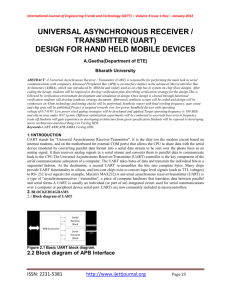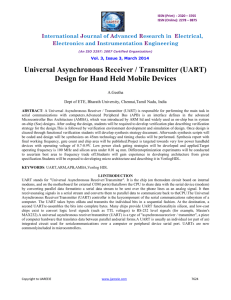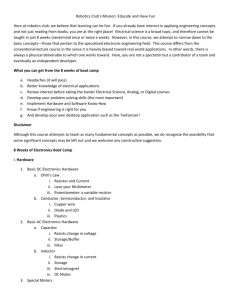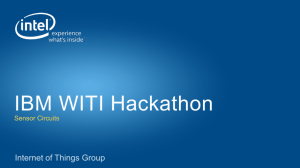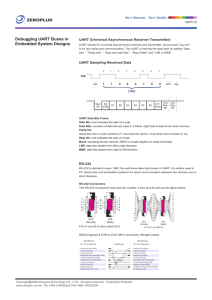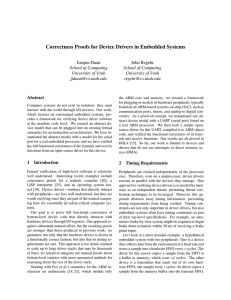UART and UART Driver B. Ramamurthy 1
advertisement
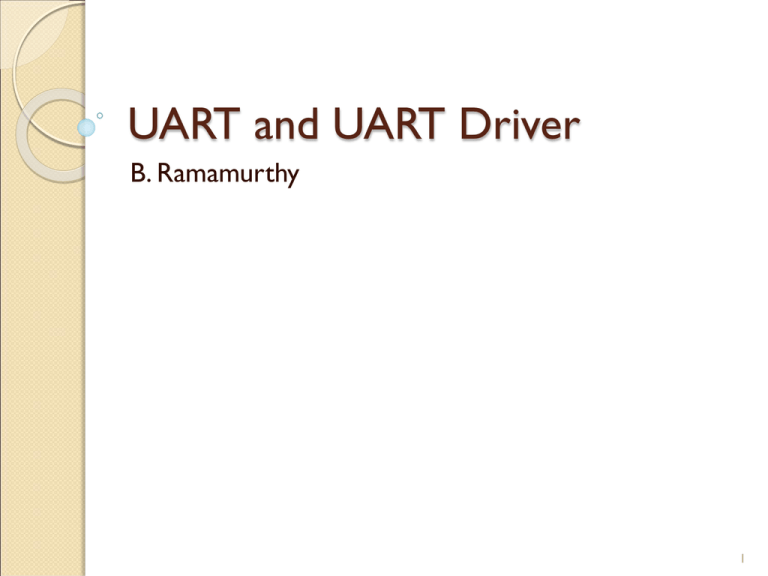
UART and UART Driver B. Ramamurthy 1 •UART UART: Universal Asynchronous Receiver/Transmitter device Device connected to the system bus; it takes parallel data converts into RS232C serial format and transmits it; and receives data in serial format and converts it to parallel format for CPU bus -- parallel byte is converted into start bit, 8 bits, parity bit and stop bit serial form and vice versa Asynchronous transmission allows data to be transmitted without the sender having to send a clock signal to the receiver. Instead, the sender and receiver must agree on timing parameters in advance and special bits are added to each word which are used to synchronize the sending and receiving units. -- That’s why you set the baud rate in your xinu environment 2 16550 UART Chip Lets study the layout and operation of 16550 UART chip. Page 1: The features Page 2: Basic chip configuration Page 6 …: RD and WR cycle timing Page 11: Pin descriptions Page 14: Register summary Page 15…: Register explanation 3 RS 232C Standard Serial communication standard. See the DE-9 pin configuration: G (5), TxD (3), RxD(2), DTR(4), DSR(6), RTS(7), CTS(8), DCD(1), RI (9) 4 XINU UART Driver xinu_mips-1.0/include/uart.h xinu_mips-1.0/uart/* Map all that you learned in the last few slides to the code in uart.h and the driver implementation in uart directory 5 References http://www.freebsd.org/doc/en/articles/serial-uart/ http://cache.national.com/ds/NS/NS16C552.pdf http://xinu.mscs.mu.edu/National_Semiconductor_ 16550_UART#Physical_UART http://en.wikipedia.org/wiki/RS-232 Linux device-driver: http://www.networkcomputing.com/unixworld/tut orial/010/010.txt.html 6 Device driver context User process Operating System: dev/xyz Device driver Physical Device hardware 7 UART Driver in EXINU General device driver related files: device.h, devtable.c 2. Uart files: uart.h defining the physical features of the uart 3. All the files in the uart directory that implement the operations related to the uart. 1. ◦ ◦ uartControl.c uartInit.c uartIntr.c uartPutChar.c uartWrite.c uartGetChar.c uartRead.c 8 Device Drivers Chapter 7 of programming embedded systems (available on Safari) On board devices are called internal peripherals and one outside are called external peripherals ◦ UART Chip (internal) ◦ TTY (external) UART transceiverRS232D-9 connector laptop serial socket ◦ See fig.7.2 and ◦ WRT54GL board and modifications 9 Serial Port Block Diagram (7.2) Processor UART Peripheral RS-232 Transceiver COM1 DB-9 connector 10 Our Setup WRT54GL Processor: BCM5353 UART Peripheral TI 16552 RS-232 Transceiver AMD202 COM1 DB-9 connector To do: Read the book Chapter 7 11 Device drivers Embedded processor interacts with a peripheral device through a set of control and status registers. Registers are part of the peripheral device. Registers within a serial controller are different from those in a timer. These devices are located in the memory space of the processor or I/O space of the processor- two types: memory-mapped or I/O mapped respectively. 12 Device driver (contd.) The keyword volatile should be used when declaring pointers to device drivers. Our text goes on to discuss bit manipulation: please read it) ◦ Bit patterns for testing, setting, clearing, toggling, shifting bits, bitmasks, and bitfields. Struct overlays: ◦ In embedded systems featuring memory mapped IO devices, it is common to overlay a C struct on to each peripheral’s control and status registers. ◦ This will provide the offsets for the various registers from the base address of the device. 1. 1 3 Device Driver Philosophy Hide the hardware completely: hardware abstraction If the device generates any interrupts include interrupt controllers. Device driver presents a generic interface for applications at higher level to access the devices: device.h Device drivers in embedded systems are different from general purpose operating systems: See diagram in slide #7 ◦ Applications in general purpose systems accesses OS (Operating Systems) which in turn accesses device drivers. ◦ Applications in embedded systems can directly access device drivers. 14 General Purpose OS vs. Embedded System Application process Application process Operating System: dev/xyz Fig 7.1 Device driver Device driver Physical Device hardware Physical Device hardware 15 Device Driver development steps (pp. 132-133) An interface to the control and status registers. 2. Variables to track the current state of the physical and logical devices -- Major and minor device number, device name 3. A routine to initialize the hardware to known state 4. An API for users of the device driver -- Read, write, seek 5. Interrupts service routines 1. 16 Example: A serial device driver Read the text for explanation and general example Now lets look at the UARTdriver of the embedded xinu and WRT54GL. Study the tty driver that is a logical device that is layered on top of the UART driver. In our Project 3 you will write a device driver for a logical device. 17 Summary We studied the design and development of device drivers. We analyzed the code for a sample UART driver. To do: read chapter 7 from embedded system book; read the UART device driver exinu and wrt54gl. 18
